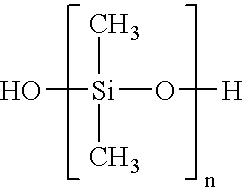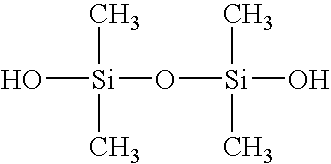Device for immobilizing chemical and biochemical species and methods of using same
a biochemical and immobilizing technology, applied in the field of recombinant dna technology, can solve the problems of difficult to conduct massive comparative genomics studies, aggressive disease-gene discovery, cost and read length, etc., and achieve the effect of high throughput format and convenient automation of methods
- Summary
- Abstract
- Description
- Claims
- Application Information
AI Technical Summary
Benefits of technology
Problems solved by technology
Method used
Image
Examples
example 1
Preparation of a Microfluidic Device
[0078] This example illustrates the process of fabricating a microfluidic device having a surface suitable for immobilization of a nucleic acid molecule.
[0079] As disclosed herein, the microfluidic device is useful in the construction of a nucleic acid sequencing device. Such a device is exemplified by the DNA-sequencing device shown by FIGS. 1A-1C.
[0080] The following reagents were used for fabrication. Hexamethyldisilazane (HMDS) from ShinEtsuMicroSi, Phoenix, Ariz. was used. Photoresist 5740 from MicroChem Corp., Newton, Mass. was used. Tetramethylchlorosilane from Aldrich was used. Poly(dimethylsiloxane) (PDMS) Sylgard 184 from Dow Corning, K. R. Anderson, Santa Clara, Calif. was used. Diacrylated poly(ethylene glycol)(DAPEG) SR610 from Sartomer, Exton, Pa. was used. The Pt catalyst was hydrogen hexachloroplatinate from Aldrich. The polyelectrolytes that were used were polyethyleneimine (PEI) from Sigma and polyacrylic acid from Aldrich. Bi...
example 2
DNA Sequencing-By-Synthesis Using a Microfluidic Device
[0086] This example illustrates the process of DNA sequencing-by-synthesis using a device as described in Example 1.
[0087] A microfluidic device fabricated as described in Example 1 was housed in a custom-built aluminum holder, which was placed in a machined attachment to the translation stage of an inverted Olympus IX50 microscope. 23-gauge steel tubes from New England Small Tube Corp. (Litchfield, N.H.) were plugged into the control channel ports of the device. Their other ends were connected through TYGON tubing (Cole-Parmer, Vernon Hills, Ill.) to Lee-valve arrays (Fluidigm Corp. South San Francisco, Calif.) and operated by LabView™ software on a personal computer. The same types of steel tubes and TYGON tubing plumbing were used to supply reagents to the flow channel ports of the device. The microscope was equipped with a mercury lamp (HBO 103 W / 2 Osram), an Olympus Plan 10× objective (NA 0.25), an Olympus PlanApo 60x obj...
PUM
| Property | Measurement | Unit |
|---|---|---|
| height | aaaaa | aaaaa |
| width | aaaaa | aaaaa |
| width | aaaaa | aaaaa |
Abstract
Description
Claims
Application Information
 Login to View More
Login to View More - R&D
- Intellectual Property
- Life Sciences
- Materials
- Tech Scout
- Unparalleled Data Quality
- Higher Quality Content
- 60% Fewer Hallucinations
Browse by: Latest US Patents, China's latest patents, Technical Efficacy Thesaurus, Application Domain, Technology Topic, Popular Technical Reports.
© 2025 PatSnap. All rights reserved.Legal|Privacy policy|Modern Slavery Act Transparency Statement|Sitemap|About US| Contact US: help@patsnap.com



